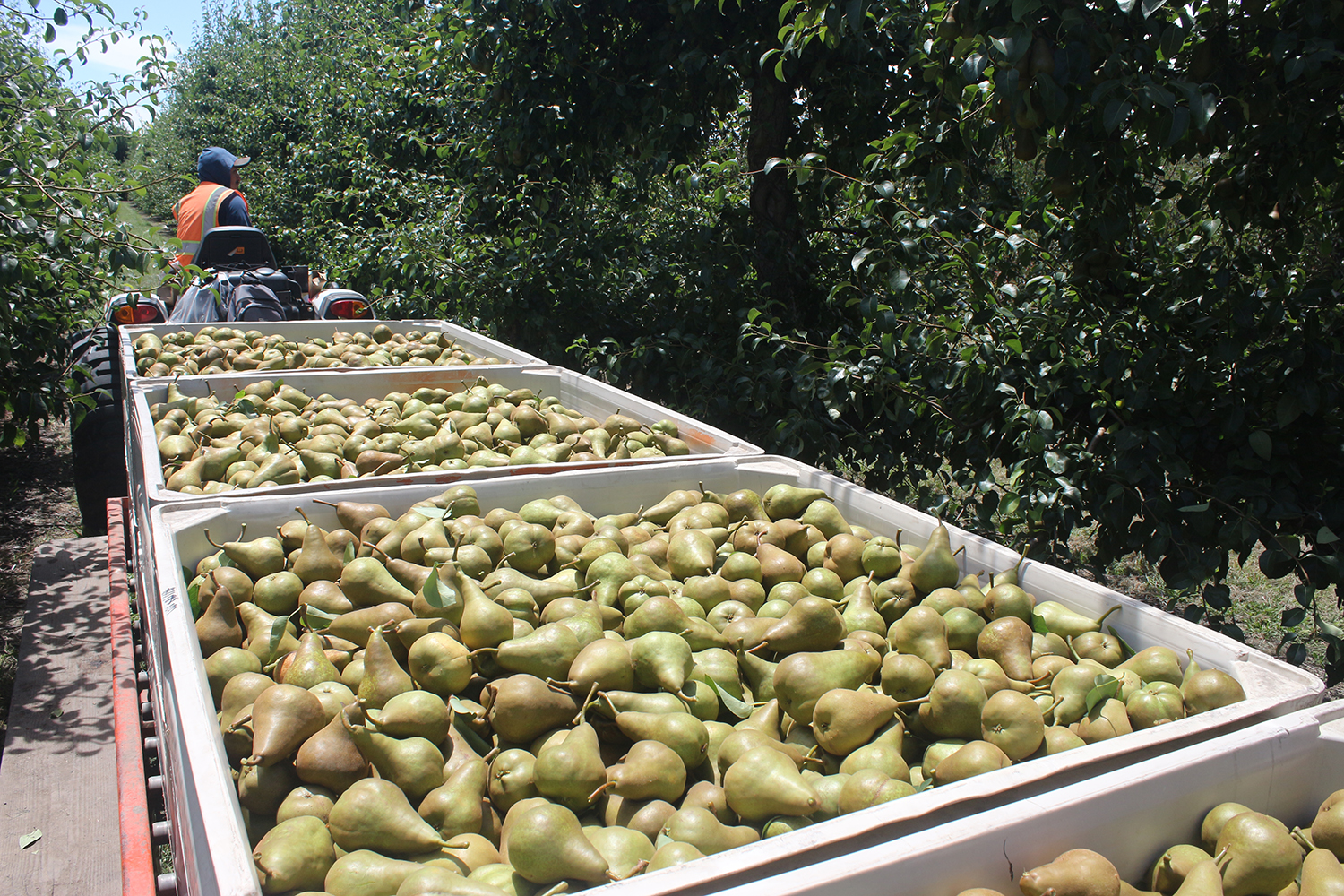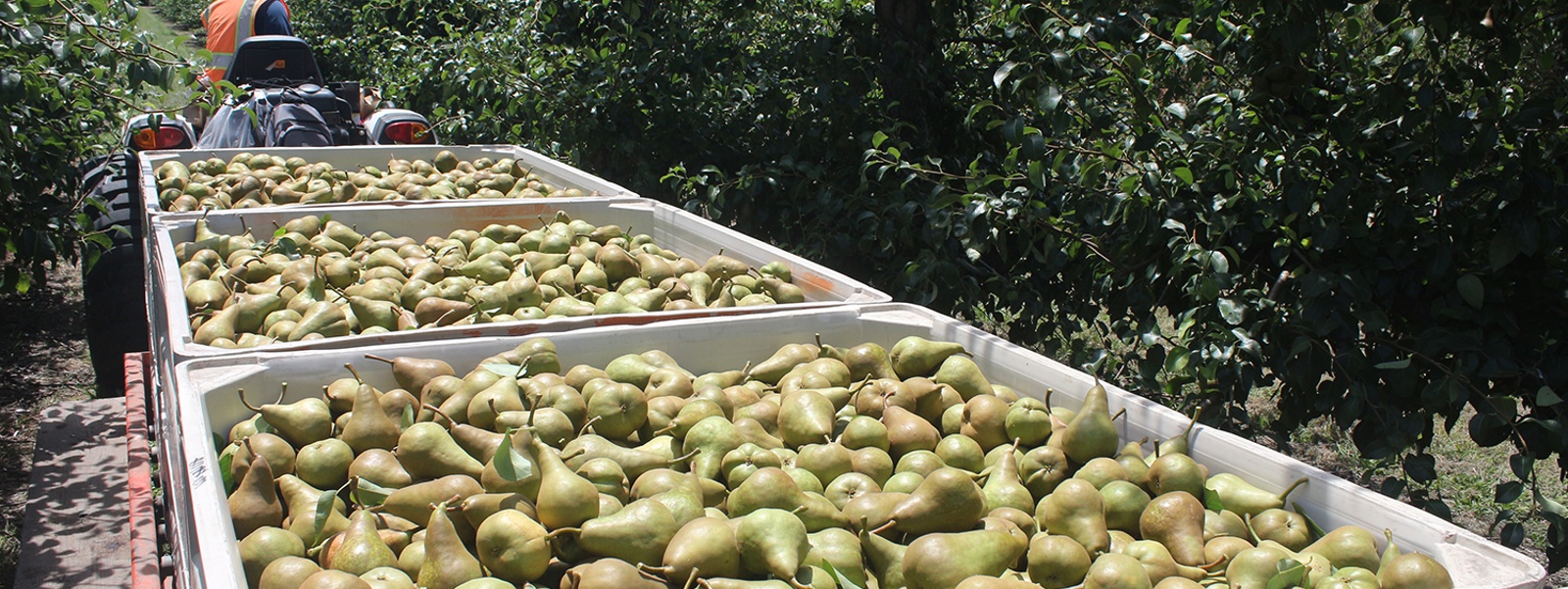Del Monte troubles shake up pear season

Bins of early-season Bosc pears from the Sacramento River Delta growing district move through the orchard on their way to the packinghouse. With a larger crop this year, California pear growers brace for potential impacts of one of their key buyers—Del Monte Foods—filing for bankruptcy protection.
Photo/Ching Lee

By Ching Lee
After lower yields last year, California pear growers say they expect to harvest more normal volumes this season. But the bigger crop comes as they grapple with the uncertain future of one of their key buyers.
Del Monte Foods, which operates one of two canneries left in the state, filed for Chapter 11 bankruptcy protection earlier this month, saying it had initiated a “restructuring process” with lenders to facilitate a sale of the business for “all or substantially all” of the company’s assets.
The move follows the Walnut Creek-based company’s announcement in May that it was closing its pear cannery and two warehouses in Yakima, Washington, and shipping the fruit to its Modesto plant. Del Monte also shuttered facilities in Washington and Wisconsin last year, when it reduced pear orders from California growers.
With Del Monte’s bankruptcy announcement, “it’s going to obviously cause some type of rebalancing” within the sector, said Alex Wilson, who grows pears for his family’s Rivermaid Trading Co. in Lodi, the state’s largest supplier of fresh pears.
“There’s a giant question mark on what that rebalancing is going to look like,” he said.
Three pear packers remain in California: Rivermaid, which handles about 50% of the state’s pears; Stillwater Orchards in Courtland, which packs only its own fruit; and Scully Packing Co. in Finley, which accounts for about 35% of the state’s fresh pear pack.
In any given year, most of the state’s pears are destined for canning, with a small amount going to other processing, such as for baby food or juice. Besides Del Monte, Lodi-based Pacific Coast Producers—a grower-owned fruit-processing cooperative—operates the state’s only other pear-canning facility, in Oroville.
For this year at least, “the latest message from Del Monte” is that it intends to honor contracts it has with Stillwater, said Ryan Elliot, its operational manager.
“There’s been no talk of being cut or adjusting the amount of tons that we have contracted with them,” he said.
In a statement, Del Monte said it has secured $912.5 million in financing from existing lenders to support its current pack season and continue operating.
In addition to Del Monte, Stillwater is also contracted to deliver pears to PCP. Both canneries are “super necessary” to his business, Elliot said, to ensure that “every piece of fruit has a home in our operation, especially in a year like this where there’s a lot of fruit on the trees.”
California growers are expected to harvest 115,397 tons of pears this year compared to 91,347 tons in 2024, which marked the smallest crop in the past five years, according to the California Pear Advisory Board.
“There’s definitely been a rebound in tonnage for this year,” said Patrick Archibeque, Rivermaid’s president and CEO.
Though Rivermaid does not contract with Del Monte, Archibeque said “a healthy canning industry” is good for the fresh market because “if one or the other gets out of balance, then it puts too much pressure on the other.”
Del Monte’s bankruptcy could mean more pears going to PCP. But Archibeque said PCP can’t absorb all the tonnage Del Monte was buying because of limited markets for canned fruit, consumption of which has been sliding for years. Despite a spike in demand during the COVID-19 pandemic as people stocked their pantries, that trend proved temporary.
In its bankruptcy filing, Del Monte said it has been highly leveraged for years, with an average balance sheet always exceeding $1 billion in debt. The sharp rise in interest rates in recent years further affected the company’s cash flow and ability to manage its finances.
At the same time, the 139-year-old canned foods giant faced market-driven pressures and economic headwinds due to “changing consumer purchase behavior and increased inflationary costs,” the filing said. Heightened demand in 2022 led Del Monte to commit to higher production volumes in 2023 only to see demand fall in 2024. With its outsized production commitments, the company incurred increased costs to move, store and manage excess inventory, according to the filing.
Even if Del Monte maintains some canning capacity in California, Rivermaid’s Archibeque said there will still be more fruit than the state’s three packers can move to the fresh market. That means growers will need to remove trees.
California pear acreage has remained at less than 5,000 since 2018 and stood at 4,500 in 2023 and 2024. That’s down from 10,610 acres in 2000, according to the pear advisory board.
“I think we will achieve an equilibrium again,” Archibeque said, “but it will be painful getting there.”
Mendocino County grower Peter Johnson, whose family has been delivering fruit to Del Monte for more than a century, said he has no current plans to take out any pears but acknowledged he may need to remove some acreage in the future.
“We’ll have to wait and see,” he said, noting his focus is on getting this year’s crop picked. “We’re keeping all our possibilities open at this point. It doesn’t help to have a beautiful crop and then not being able to sell it or process it.”
Stillwater’s Elliot said his company is working to run more fruit through its packing shed so it doesn’t have to remove trees. It’s also trying to find new markets, specifically with wholesalers in the Midwest and different parts of the country, he added.
“We want to read the tea leaves and be prepared for the worst,” Elliot said.
For this year, another big question facing California pear growers is what happens to the Pacific Northwest fruit left in the wake of Del Monte’s Yakima plant closure and how it would impact prices if it found its way to the fresh market, said Pat Scully, general manager of Scully Packing. Washington’s crop, which hits the market about mid-August, is projected to be bigger than last year, he noted.
“That’s a concern,” Scully said. “I think the next couple of months will tell a bigger story of how this is going to unfold.”
Ching Lee is editor of Ag Alert. She can be reached at clee@cfbf.com.




